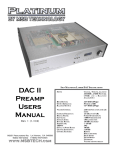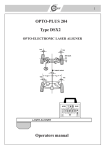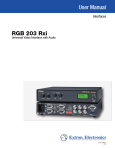Download Patch Bays - WordPress.com
Transcript
Patch Bays Let's take a look at an earlier mode of switching: a patch bay. A patch bay is simply a junction panel of connector jacks (patch points) that serve as a convenient location for making system connections. It consists of two or more rows of connector jacks wired with various signals from equipment rear panels. The top rows usually consist of outputs; the bottom rows have the inputs. Source outputs are usually directly above their "normal" input destination. When no patch cable is connected between normal output and input, the signal flow is "normalized." Patch cables have identical connectors on each end and are used to connect the desired output to the desired input. This interrupts the normal signal path and redirects the selected output into a new input. Switchers Switchers may be thought of as hardwired patch bays. They are used whenever signals need to be moved around a system quickly and simply. They route signals by the simple press of a button. Switchers may route the following signal types: • • • • Video Audio Time code Serial control A switcher is an electronic switching device that eliminates the need to make a manual, mechanical patch. Most often many signals are input and one signal is output from the switcher. Switching Applications Switchers can be used in a wide range of applications where multiple video and/or audio sources are being displayed by one or more devices such as lecture halls, conference rooms, command and control centers, and home theaters. In the diagram shown here, up to six computer-video inputs with balanced or unbalanced audio can be routed to a monitor and a sound system. In addition, Extron switchers offer a wide variety of control features, video connection types, size, and performance that allow them to fulfill any system requirement. Matrix Switching Switchers may have several inputs and several outputs. These are called matrix switchers. Using an internal distribution amplifier (DA) and switcher, a matrix switcher can simultaneously switch a variety of sources to more than one output — a task that would ordinarily require several devices and lots of cables. The number of inputs and outputs specifies a matrix switcher. For example, a 4x4 matrix switcher has four inputs and four outputs. Benefits and Functions of Switchers Benefits • • • Allows the user to centralize and isolate inputs for managing video and audio sources Permits more input selection to the display device Provides simple input selection buttons and other control capabilities to allow the user more control options Functions When connected to the sources and the display device, the switcher allows the user to select any input and display that input on a display device. Active Switching RGB video switching is generally made through passive or active circuitry. In an active switcher, the input signal is sent through active electronic circuitry to buffer the signal. This helps to maintain the integrity of the signal and can be used to compensate for low level horizontal and vertical sync and bring them up to the appropriate level. Some signal processors can also "actively" switch between signal types, such as RGBS to RGBHV. Passive Switching Passive switching means that there are no electronic changes made to the signal. Whatever signal is sent into the switcher is what the output will be. One advantage of a passive switcher is that it is also bi-directional. It can be a switcher and/or an RGB video router. Both outputs cannot be displayed simultaneously. However, this allows you to choose (switch) which output device will receive the signal. Since there are no electronic components altering the video signal, passive switchers will usually have a higher bandwidth which results in higher performance Switcher Categories Having determined the input and display requirements, one of the following categories should provide the switching solution. Audio/Video switchers - Accept composite video, S-video, component, SDI, and/or stereo audio with several inputs to choose from. With the ability to switch NTSC, PAL, and SECAM formats, these switchers provide worldwide compatibility. Computer and RGB switchers - Designed for routing computer video signals. They are available in dedicated models that feature VGA (15-pin HD) or BNC input and output connectors. System switchers - Compatible with all types of digitally controlled projectors. Accept virtually all source signals. System switchers feature projector control. Seamless switchers - Extron's seamless switchers perform glitch-free switching, which eliminates visible switching artifacts between sources. These switchers provide seamless cuts and transition effects making presentations look more professional. Matrix switchers - Matrix switchers route multiple A/V sources to multiple A/V destinations. These switchers allow A/V signals from a range of input sources such as computers, cameras, and DVD players to be displayed on different output sources, such as projectors, monitors, and codecs. Let's take a closer look at each of thesePassive switching means that there are no electronic changes made to the signal. Whatever signal is sent into the switcher is what the output will be. One advantage of a passive switcher is that it is also bidirectional. It can be a switcher and/or an RGB video router. Both outputs cannot be displayed simultaneously. However, this allows you to choose (switch) which output device will receive the signal. Since there are no electronic components altering the video signal, passive switchers will usually have a higher bandwidth which results in higher performance Passive switching means that there are no electronic changes made to the signal. Whatever signal is sent into the switcher is what the output will be. One advantage of a passive switcher is that it is also bi-directional. It can be a switcher and/or an RGB video router. Both outputs cannot be displayed simultaneously. However, this allows you to choose (switch) which output device will receive the signal. Since there are no electronic components altering the video signal, passive switchers will usually have a higher bandwidth which results in higher performance. Passive switching means that there are no electronic changes made to the signal. Whatever signal is sent into the switcher is what the output will be. One advantage of a passive switcher is that it is also bi-directional. It can be a switcher and/or an RGB video router. Both outputs cannot be displayed simultaneously. However, this allows you to choose (switch) which output device will receive the signal. Since there are no electronic components altering the video signal, passive switchers will usually have a higher bandwidth which results in higher performance. Fine modulo by the combinations of video and audio formats each accepts. With the ability to accept NTSC, PAL, and SECAM formats, these switchers provide worldwide compatibility. The Extron SW 4AV (shown here) is a high-performance composite video with stereo audio switcher. This switcher features a genlock input and vertical interval switching, providing synchronization of video signals of one device with those from another video source and resulting in smooth and clean transitions when switching between inputs. The SW 4AV also includes adjustable gain and attenuation, allowing users to set the individual input audio levels, providing no significant difference in volume when switching between sources. All SW AV switchers can be controlled via the front panel buttons, RS-232, or via optional remote control devices. The SW 4AV has 250 MHz (-3dB) of bandwidth. Video inputs are on female BNC connectors. Two individually buffered composite video outputs are also female BNC connectors. The SW 4AV accepts balanced/unbalanced stereo audio on captive screw connectors. Computer and RGB Switchers The Extron VGA and RGB routing computer-video dedicated models that BNC input and output RGBHV Series are active BNC connectors. There are SW2 RGBHV, SW4 two, four, and six input respectively. The SW2 SW6 RGBHV A (pictured six input RGBHV several audio features. All models in this series RGsB, RsGsBs, RGB video/sync (Europe SCART connections) or component video with stereo audio sources to be switched to one compatible display device. With 350 MHz (-3dB) of bandwidth, the SW RGBHV A Series switchers can support a wide array of high resolution signals. switchers are designed for signals. They are available in feature VGA (15-pin HD) or connectors. For example, the Extron SW analog RGBHV switchers using six switchers in the series. The RGBHV, and SW6 RGBHV are RGBHV video-only switchers, RGBHV A, SW4 RGBHV A and here) are also two, four, and switchers, but also include allow multiple RGBHV, RGBS, source inputs with composite System Switchers Extron system switchers provide universal projector control via IR or RS-232 and accept virtually all source signals. With system switchers, it is easy to switch between computers, A/V components, and audio sources. The Extron System 7SC is a seven input, dual output, multi-format active switcher with a builtin video scaler. The System 7SC features projector and room control along with RGB and video integration capabilities ideal for permanent installations and staging applications using plasma displays as well as CRT, LCD, D-ILA®/LCoS, and DLP™ projectors. Seamless Switchers The Extron seamless switchers perform glitch-free switching, eliminating visible switching artifacts between sources. These switchers provide seamless cuts and transition effects making presentations look more professional. The sample product featured here is the Extron ISS Series Integration Seamless Switcher. It provides truly seamless, glitch-free switching between eight inputs, each of which is fully configurable for all video types. The ISS Series combines flawless switching between every type of video signal and superior scaling technology with proprietary Extron technologies like 3:2 and 2:2 pulldown, Dynamic Motion Interpolation (DMI™), and Accu-RATE Frame Lock (AFL™). With features like 16 auto-memory presets per input and test patterns for projector setup, the ISS Series is the ideal solution for professional A/V applications that incorporate digital projectors and displays, such as boardrooms, conference rooms, classrooms, churches, and auditoriums where glitch-free, seamless switching and professional transitions between A/V sources are essential. Click here for additional information. Matrix Switchers Matrix switchers allow for the switching of multiple inputs and multiple outputs, offering flexible routing of video and audio signals for complex installations. Any input can be routed to any or all outputs. Switching operations can be triggered using front panel buttons or remotely via RS-232 serial commands. Common input/output patching configurations can be stored and executed simultaneously. The Extron Matrix 3200 and Matrix 6400 Series switchers are just one of many solutions for large scale routing applications for up to 128 inputs and 128 outputs (Matrix 12800). With user-friendly control via the front panel, MKP 1000/2000/3000 remote keypads, or MCP 1000 Master Control Panel, the Matrix 3200 and 6400 switchers provide totally customizable and modular switching of composite video, S-video, component video, RGsB, RGBS, RGBHV, and one or two channel audio. With a bandwidth of 430 MHz (-3dB) fully loaded, the Matrix 3200 and 6400 Series can maintain the integrity of any routed signal. Benefits and Functions of Matrix Switchers Benefits • • • Matrix switchers provide the ability to route any input to any output, or multiple outputs, at any time. Depending on the model, matrix switchers can route composite video, S-video, HDTV/component video, serial digital video (SDI), RGsB/RGBS/RGBHV video and/or stereo audio (balanced/unbalanced). Matrix switchers can accommodate multiple signal types within a single unit; however, a signal type that is input can only be routed to an output of the same signal type. In other words, composite video inputs can only go to composite video outputs. Note: this is not true with matrix switchers with built-in scalers. Functions The matrix switcher, when connected to the sources and the display device, allows the user to select any input to any output display device. Matrix Switcher Categories Extron's matrix switcher series are available with a variety of features to meet the needs of different applications. Configurations range from 4x2 (four inputs by two outputs) to 128x128 (128 inputs by 128 outputs). For additional flexibility, inputs and outputs can be added to specific switcher lines (described as "modular") while they are in the field. Each matrix switching application is unique. That's why Extron offers several categories of matrix switchers, including: • • • • • • • • • • • • • Composite Video S-Video HDTV-Component Video Stereo Audio Serial Digital (SDI) VGA Wideband RGB Ultra-Wideband RGB Configurable Scaling Media Presentation Twisted Pair and Matrix Switcher Accessories Switcher Features Below is a short list of some of the features available on Extron switchers. For more complete information, please check the product catalog or the Web site. Video Genlock – Broadcast quality NTSC, PAL, or SECAM video genlock capabilities allow for vertical interval switching. This enables smooth, seamless transitions when switching between inputs. Audio Breakaway – Provides the capability to break away an audio signal from its corresponding video signal. Usually accomplished via RS-232 although some matrix switchers can accomplish via front panel control. Simple Instruction Set (SIS™) – Extron's SIS is a set of basic ASCII code commands that provide simple control through a third party control system. Instead of programming in long, obscure strings of code, the SIS makes it easy to operate an Extron product using RS-232/422 control. Matrix Switcher Features Global Presets – These store commonly used switching configurations. Any preset may be recalled from the front panel or RS-232 control. When a preset is recalled, all the new I/O connections occur simultaneously. Digital Sync Validation Processing (DSVP™) – Extron's exclusive DSVP verifies active sources by scanning all inputs for active sync signals. DSVP then transmits the horizontal and vertical scan rate information to the user via any type of control system using RS-232/422 commands. Advanced Digital Sync Processing (ADSP™) – an all-digital process that corrects and restores the sync signal as it passes through the switcher. QuickSwitch Front Panel Controller (QS-FPC™) – The QS-FPC feature allows for touch-ofa-button input and output selection. Extron QuickSwitch technology eliminates the learning curve usually associated with switching the inputs and outputs of a matrix switcher by using a tactile front panel button for every input and output. Front Panel Security Lockout – If installed in an unsecured environment, an optional security lockout feature may be implemented. During lockout mode, a special button combination is required to operate the front panel controller. IP Link® – Extron IP Link Ethernet control provides connectivity via any Ethernet network or TCP/IP connection. IP Link enables the product to be accessed from anywhere on the network – from multiple sites or even over the Internet. Matrix Switcher Features - I/O Grouping I/O grouping allows a matrix switcher to be virtually divided into smaller sub-switchers, making installation and control easier. I/O grouping allows specific outputs to be grouped together – such as those designated for a specific video format. Matrix Switcher Features - Rooming Using a feature called "rooming," some matrix switchers can be configured to group multiple outputs to specific "rooms," allowing them to have their own presets. Each room can consist of up to 16 signals and each matrix can support up to 10 rooms. A total of 100 room presets are available, providing added flexibility and convenience, particularly in systems where switching is required between several locations. Switcher Selection To select the right switcher for a specific environment, begin by identifying the following things: 1. What is the source signal (e.g., computer, composite video, S-video, RGB, stereo audio)? 2. What is the connector type (e.g., BNC, 15-pin HD, 4-pin mini-DIN, 3.5 mm)? 3. Do you need to switch both video and audio sources? 4. What type of device will display the signals (e.g., CRT, LCD panel, DLP display, audio speaker)? Matrix Switcher Selection To select the right matrix switcher for a specific environment, there are some additional "rulesof-thumb" to keep in mind: 1. Matrix switchers provide the ability to route any input to any output—or multiple outputs—at any time. 2. Depending on the model, matrix switchers can route composite video, S-video, HDTV/component video, RGsB/RGBS/RGBHV video, and/or stereo audio (balance/unbalanced). 3. Matrix switchers can accommodate multiple signal types within a single unit, but like inputs can only be routed to like outputs; for example, composite video inputs can only go to composite video outputs.























